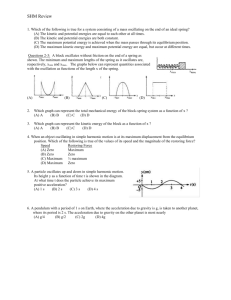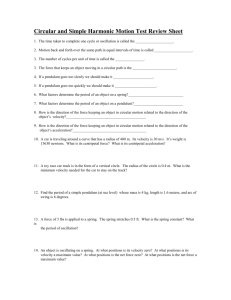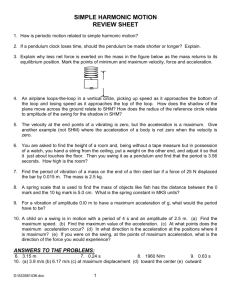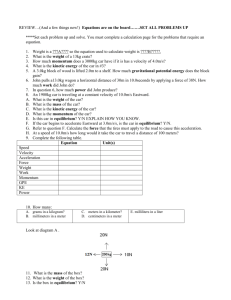Tutorial Topic 6
advertisement
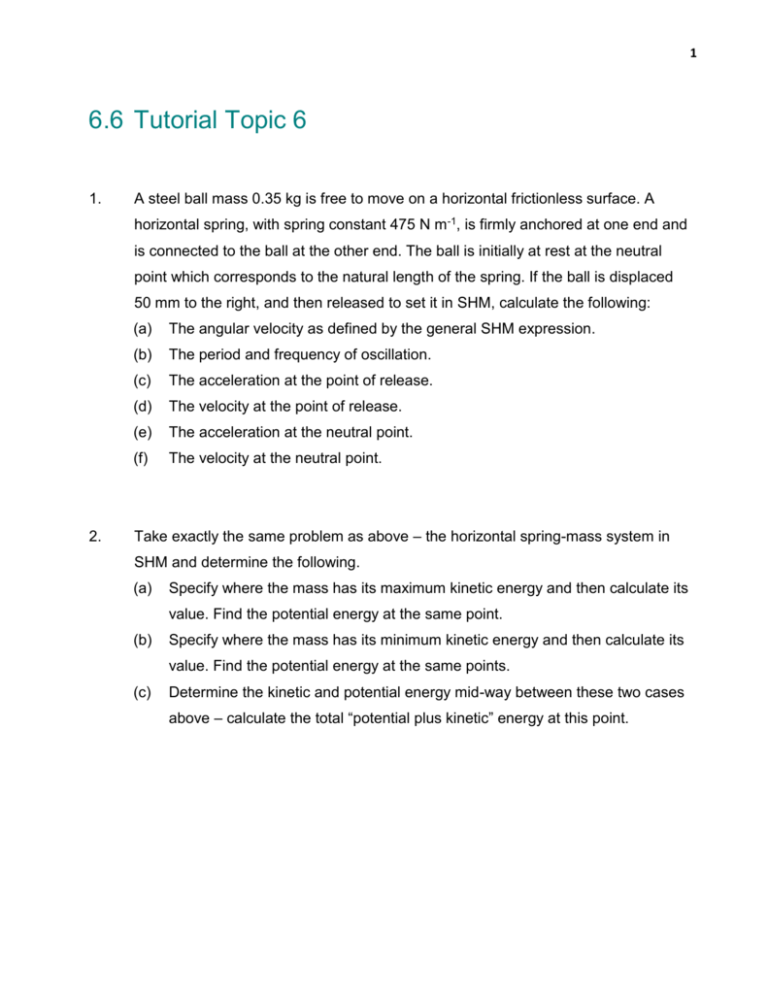
1 6.6 Tutorial Topic 6 1. A steel ball mass 0.35 kg is free to move on a horizontal frictionless surface. A horizontal spring, with spring constant 475 N m-1, is firmly anchored at one end and is connected to the ball at the other end. The ball is initially at rest at the neutral point which corresponds to the natural length of the spring. If the ball is displaced 50 mm to the right, and then released to set it in SHM, calculate the following: 2. (a) The angular velocity as defined by the general SHM expression. (b) The period and frequency of oscillation. (c) The acceleration at the point of release. (d) The velocity at the point of release. (e) The acceleration at the neutral point. (f) The velocity at the neutral point. Take exactly the same problem as above – the horizontal spring-mass system in SHM and determine the following. (a) Specify where the mass has its maximum kinetic energy and then calculate its value. Find the potential energy at the same point. (b) Specify where the mass has its minimum kinetic energy and then calculate its value. Find the potential energy at the same points. (c) Determine the kinetic and potential energy mid-way between these two cases above – calculate the total “potential plus kinetic” energy at this point. 2 3. A steel ball mass 0.35 kg is free to move in a vertical direction. A vertical spring, with spring constant 475 N m-1, is firmly anchored at one end and is connected to the ball at the other end. The ball is supported only by the spring and is allowed to come to rest in the Earth’s gravitational field before the system is set in motion. If the ball is now displaced 50 mm vertically downwards, and then released to set it in SHM, calculate the following: 4. (a) The angular velocity as defined by the general SHM expression. (b) The period and frequency of oscillation. (c) The acceleration at the point of release. (d) The velocity at the point of release. (e) The acceleration at the neutral point. (f) The velocity at the neutral point. A simple pendulum has a “bob” with mass 0.4 kg is to be set in SHM to drive a clock mechanism – take it that the displacement angle applied to this pendulum is small. If the period of oscillation is to be one second calculate the length pendulum needed and then determine the following – assume that the initial displacement of the bob, to the right of the neutral point, is 0.15 m: (a) The angular velocity as defined by the general SHM expression. (b) The frequency of oscillation. (c) The acceleration at the point of release. (d) The velocity at the point of release. (e) The acceleration at the neutral point. (f) The velocity at the neutral point. 3 5. Now repeat the above – the simple pendulum in SHM and determine the following. (a) Specify where the mass has its maximum kinetic energy and then calculate its value. Find the potential energy at the same point. (b) Specify where the mass has its minimum kinetic energy and then calculate its value. Find the potential energy at the same points. (c) Determine the kinetic and potential energy mid-way between these two cases above – calculate the total “potential plus kinetic” energy at this point. 6. A spring has a spring constant of 300 Nm-1. Calculate the magnitude of the force needed for the following circumstances: 7. (a) When it is stretched the by 3mm from its unstrained length. (b) When it is compressed by the same amount. A room is 2.30 m high and a spring, unstrained length 0.35 m, hangs from the ceiling. Attached to the free-end of the spring is a board, 1.88 m in length and mass 10kg. The board extends to, but does not touch, the floor. Given all of the above calculate the spring constant. 8. An object is in Simple Harmonic Motion (SHM) with an angular velocity of ………... ω = 3.4 rad s-1 and amplitude 0.30 m. What is the velocity of the object when its displacement is 0.15 m from the equilibrium point (neutral point). 9. Atoms in a solid are not stationary, but vibrate about their equilibrium positions; typically, the frequency of vibration is about f = 2 x 1012 Hz, and the amplitude is about 1 x 10-11 m. For a typical atom, as described above, determine its maximum velocity and acceleration. 4 10. Initially a conical pendulum, length 0.5 m, is displaced by 7o from the vertical – take gravitational acceleration to be g = 9.8 ms-2. Under these initial conditions calculate the period of the pendulum then determine the following: (a) The period of the pendulum if its length is increased to 1.5m. (b) The angle that the bob makes with the vertical when is period is 10.0 seconds and its length is 10 m.
